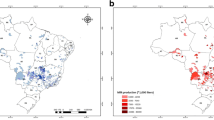Abstract
This paper investigates the spatial distribution of cattle breeders in Texas to quantify how climate factors influence cattle breed selection. A multivariate probit model is employed to examine the county-level binary choices of Bos taurus, Bos indicus and composite breeds derived from cattle breed association membership data. The estimation results suggest that summer heat stress is a significant factor for breed selection: positive for Bos indicus and negative for Bos taurus and composite breeds, with the average marginal effects on breed membership probability being 9.7 %, −26.5 % and −7.9 %, respectively. The intensity of the summer heat impacts can lead to noteworthy changes in spatial distributions of Texas cattle breeds in the event of climate change.





Similar content being viewed by others
References
Adams RM, McCarl BA, Segerson K, Rosenzweig C, Bryant KJ, Dixon BL, Conner R, Evenson RE, Ojima D (1999) Economic effects of climate change on US agriculture. In: Mendelsohn R, Neumann JE (eds) The impact of climate change on the United States economy. Cambridge University Press, Cambridge, pp 18–54
Bade DH (1998) Management of improved pastures for optimal performance. Tex Agric Ext Serv
Baker BB, Hanson JD, Bourdon RM, Eckert JB (1993) The potential effects of climate change on ecosystem processes and cattle production on U.S. rangelands. Clim Chang 25:97–117
Cappellari L, Jenkins SP (2003) Multivariate probit regression using simulated maximum likelihood. The Stata J 3:278–294
Craine JM, Elmore AJ, Olson KC, Tolleson D (2010) Climate change and cattle nutritional stress. Glob Chang Biol 16:2901–2911
Falconer LL, Parker JL, McGrann JM (1999) Cos of production analysis for the Texas cow-calf industry. Tex J Agric Nat Resour 12:7–13
Greene WH (2003) Econometric analysis. Prentice Hall, Uppder Saddle River
Greiner SP (2009) Beef cattle breeds and biological types. Virginia Cooperative Extension, Virginia Tech, and Virginia State University
Hammack SP (2010a) Texas adapted genetic strategies for beef cattle I: an overview. Tex AgriLife Ext
Hammack SP (2010b) Texas adapted genetic strategies for beef cattle II: genetic-environmental interaction. Tex AgriLife Ext
Hammack SP (2010c) Texas adapted genetic strategies for beef cattle V: type and breed characteristics and uses. Tex AgriLife Ext
Hawkes JM, Lillywhite JM, Simonsen J (2008) Breed influence on feeder calf prices. N M State Univ Circular 634:8
Hoffmann I (2010) Climate change and the characterization, breeding and conservation of animal genetic resources. Anim Genet 41:32–46
IPCC WGI (2007) Climate change 2007: the physical science basis. contribution of working group I to the fourth assessment report of the intergovernmental panel on climate change. Cambridge University Press, New York
Lawrence MG (2005) The relationship between relative humidity and the dewpoint temperature in moist air: a simple conversion and applications. Bull of Am Meteorol Soc 86:225–233
Mader TL, Frank KL, Harrington JA Jr, Hahn GL, Nienaber JA (2009) Potential climate change effects on warm-season livestock production in the Great Plains. Clim Chang 97:529–541
Mader TL, Johnson LJ, Gaughan JB (2010) A comprehensive index for assessing environmental stress in animals. J Anim Sci 88:2153–2165
Mendelsohn R, Nordhaus WD, Shaw D (1994) The impact of global warming on agriculture: a Ricardian analysis. Am Econ Rev 84:753–771
Meyer L (2010) Section 9: key beef cattle marketing concepts. The Kentucky Beef Book. http://www.ca.uky.edu/agc/pubs/id/id108/id108.htm, pp 127–133
Miller AJ, Faulkner DB, Knipe RK, Strohbehn DR, Parrett DF, Berger LL (2001) Critical control points for profitability in the cow-calf enterprise. Prof Anim Sci 17:295–302
Mu J, McCarl BA (2011) Adaptation to climate change: land use and livestock management change in the U.S. Southern Agricultural Economics Association Annual Meeting, Corpus Christi, Texas
Paschal JC (2011) Beef cattle breeds and breeding systems in South Texas. Texas AgriLife Extension. http://cnrit.tamu.edu/cgrm/whatzhot/paschal.html. Accessed 1 July 2011
Rose SK, McCarl BA (2008) Greenhouse gas emissions, stabilization and the inevitability of adaptation: challenges for U.S. agriculture. Choices 23(1):15–18
Schimmelpfennig D, Lewandrowski J, Tsigas M, Parry I (1996) Agricultural adaptation to climate change: issues of longrun sustainability. U.S. Department of Agriculture, Washington DC
Schlenker W, Hanemann WM, Fisher AC (2006) The impact of global warming on U.S. agriculture: an econometric analysis of optimal growing conditions. Rev Econ Stat 88:113–125
Seo SN, Mendelsohn R, Dinar A, Kurukulasuriya P (2009) Adapting to climate change mosaically: an analysis of African livestock management by agro-ecological zones. The B.E. J of Econ Anal & Policy 9:Article 4
Seo SN, McCarl BA, Mendelsohn R (2010) From beef cattle to sheep under global warming? An analysis of adaptation by livestock species choice in South America. Ecol Econ 69:2486–2494
Smith R, Lacefield G, Burris R, Ditsch D, Coleman B, Lehmkuhler J, Henning J (2011) Rotational grazing. Cooperative Extension Service, University of Kentucky
St-Pierre NR, Cobanov B, Schnitkey G (2003) Economic losses from heat stress by US livestock industries. J Dairy Sci 86:E52–E77
Turner JW (1980) Genetic and biological aspects of Zebu adaptability. J Anim Sci 1201–1206
U.S. Global Change Research Program (2009) Regional climate change impacts. In: Karl TR, Melillo JM, Peterson TC, Hassol SJ (eds) Global climate change impacts in the United States. Cambridge University Press, New York, pp 107–150
Winder JA, Rankin BJ, Bailey CC (1992) Maternal performance of Hereford, Brangus, and reciprocal crossbred cows under semidesert conditions. J Anim Sci 70:1032–1038
Zilberman D, Liu X, Roland-Holst D, Sunding D (2004) The economics of climate change in agriculture. Mitig Adapt Strateg Glob Chang 9:365–382
Author information
Authors and Affiliations
Corresponding author
Additional information
The authors thank the three anonymous reviewers for their helpful comments and suggestions and those who offered suggestions at the presentation of this topic at the 2011 Agricultural and Applied Economics Association Annual Meetings in Pittsburgh, PA. The views presented in this paper are those of the authors and not those of the U.S. Department of Agriculture.
Rights and permissions
About this article
Cite this article
Zhang, Y.W., Hagerman, A.D. & McCarl, B.A. Influence of climate factors on spatial distribution of Texas cattle breeds. Climatic Change 118, 183–195 (2013). https://doi.org/10.1007/s10584-012-0642-y
Received:
Accepted:
Published:
Issue Date:
DOI: https://doi.org/10.1007/s10584-012-0642-y




